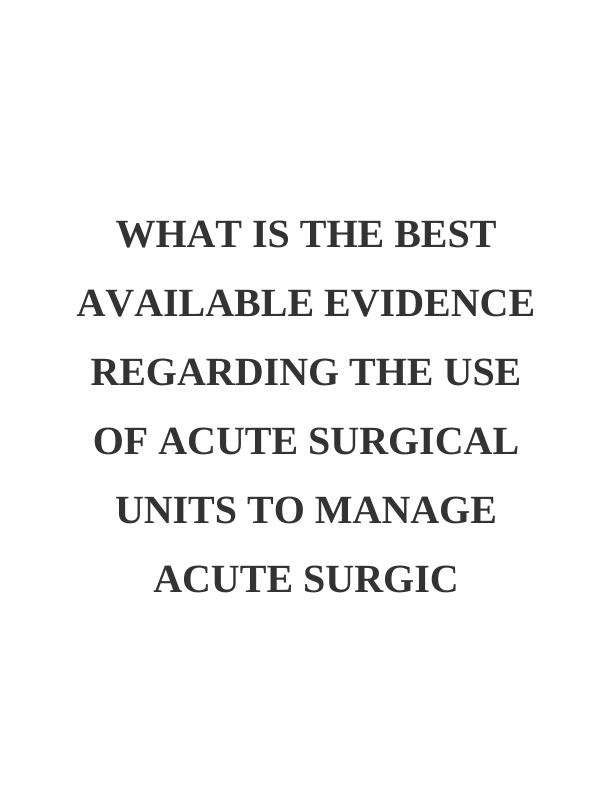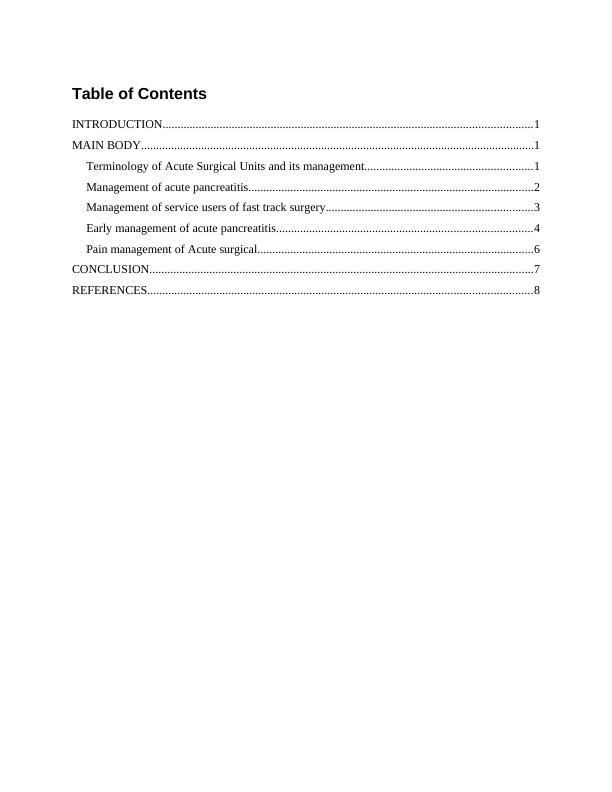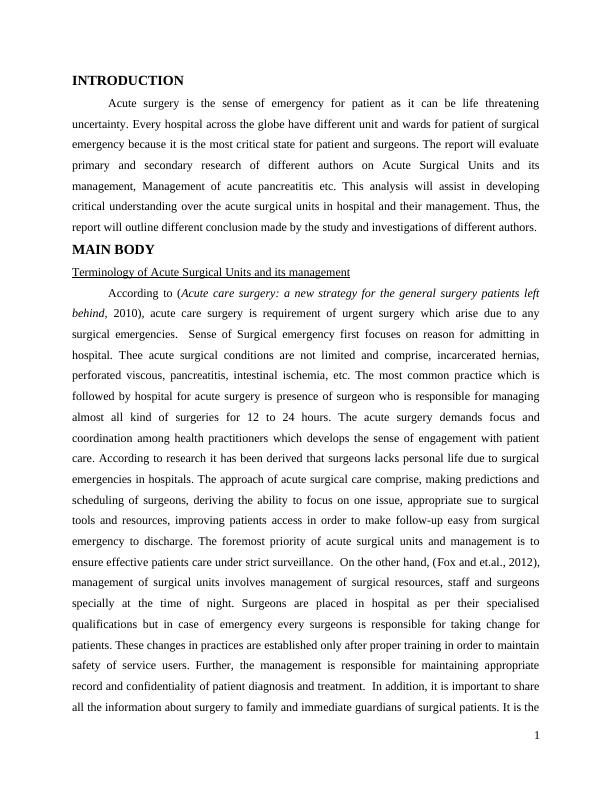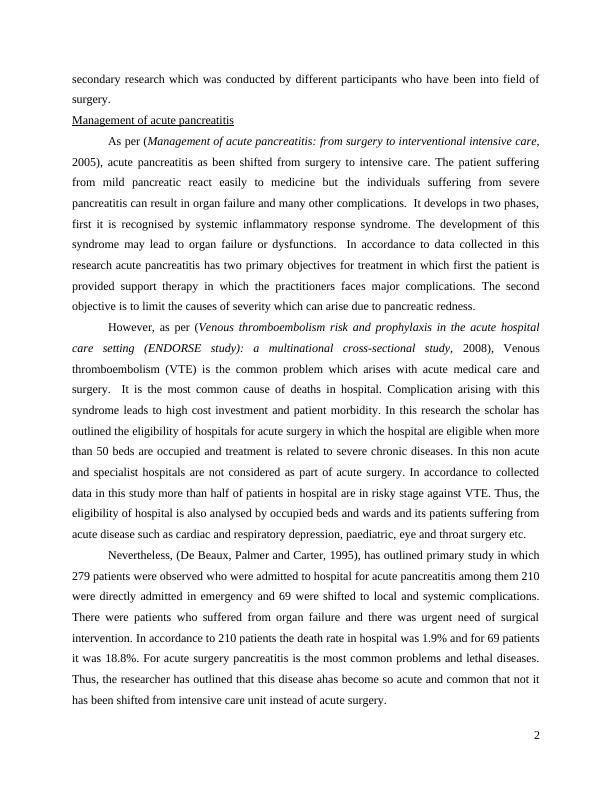Best Evidence on Acute Surgical Units and Management
Added on 2023-03-21
11 Pages3193 Words70 Views
WHAT IS THE BEST
AVAILABLE EVIDENCE
REGARDING THE USE
OF ACUTE SURGICAL
UNITS TO MANAGE
ACUTE SURGIC
AVAILABLE EVIDENCE
REGARDING THE USE
OF ACUTE SURGICAL
UNITS TO MANAGE
ACUTE SURGIC

Table of Contents
INTRODUCTION...........................................................................................................................1
MAIN BODY...................................................................................................................................1
Terminology of Acute Surgical Units and its management........................................................1
Management of acute pancreatitis...............................................................................................2
Management of service users of fast track surgery.....................................................................3
Early management of acute pancreatitis.....................................................................................4
Pain management of Acute surgical............................................................................................6
CONCLUSION................................................................................................................................7
REFERENCES................................................................................................................................8
INTRODUCTION...........................................................................................................................1
MAIN BODY...................................................................................................................................1
Terminology of Acute Surgical Units and its management........................................................1
Management of acute pancreatitis...............................................................................................2
Management of service users of fast track surgery.....................................................................3
Early management of acute pancreatitis.....................................................................................4
Pain management of Acute surgical............................................................................................6
CONCLUSION................................................................................................................................7
REFERENCES................................................................................................................................8

INTRODUCTION
Acute surgery is the sense of emergency for patient as it can be life threatening
uncertainty. Every hospital across the globe have different unit and wards for patient of surgical
emergency because it is the most critical state for patient and surgeons. The report will evaluate
primary and secondary research of different authors on Acute Surgical Units and its
management, Management of acute pancreatitis etc. This analysis will assist in developing
critical understanding over the acute surgical units in hospital and their management. Thus, the
report will outline different conclusion made by the study and investigations of different authors.
MAIN BODY
Terminology of Acute Surgical Units and its management
According to (Acute care surgery: a new strategy for the general surgery patients left
behind, 2010), acute care surgery is requirement of urgent surgery which arise due to any
surgical emergencies. Sense of Surgical emergency first focuses on reason for admitting in
hospital. Thee acute surgical conditions are not limited and comprise, incarcerated hernias,
perforated viscous, pancreatitis, intestinal ischemia, etc. The most common practice which is
followed by hospital for acute surgery is presence of surgeon who is responsible for managing
almost all kind of surgeries for 12 to 24 hours. The acute surgery demands focus and
coordination among health practitioners which develops the sense of engagement with patient
care. According to research it has been derived that surgeons lacks personal life due to surgical
emergencies in hospitals. The approach of acute surgical care comprise, making predictions and
scheduling of surgeons, deriving the ability to focus on one issue, appropriate sue to surgical
tools and resources, improving patients access in order to make follow-up easy from surgical
emergency to discharge. The foremost priority of acute surgical units and management is to
ensure effective patients care under strict surveillance. On the other hand, (Fox and et.al., 2012),
management of surgical units involves management of surgical resources, staff and surgeons
specially at the time of night. Surgeons are placed in hospital as per their specialised
qualifications but in case of emergency every surgeons is responsible for taking change for
patients. These changes in practices are established only after proper training in order to maintain
safety of service users. Further, the management is responsible for maintaining appropriate
record and confidentiality of patient diagnosis and treatment. In addition, it is important to share
all the information about surgery to family and immediate guardians of surgical patients. It is the
1
Acute surgery is the sense of emergency for patient as it can be life threatening
uncertainty. Every hospital across the globe have different unit and wards for patient of surgical
emergency because it is the most critical state for patient and surgeons. The report will evaluate
primary and secondary research of different authors on Acute Surgical Units and its
management, Management of acute pancreatitis etc. This analysis will assist in developing
critical understanding over the acute surgical units in hospital and their management. Thus, the
report will outline different conclusion made by the study and investigations of different authors.
MAIN BODY
Terminology of Acute Surgical Units and its management
According to (Acute care surgery: a new strategy for the general surgery patients left
behind, 2010), acute care surgery is requirement of urgent surgery which arise due to any
surgical emergencies. Sense of Surgical emergency first focuses on reason for admitting in
hospital. Thee acute surgical conditions are not limited and comprise, incarcerated hernias,
perforated viscous, pancreatitis, intestinal ischemia, etc. The most common practice which is
followed by hospital for acute surgery is presence of surgeon who is responsible for managing
almost all kind of surgeries for 12 to 24 hours. The acute surgery demands focus and
coordination among health practitioners which develops the sense of engagement with patient
care. According to research it has been derived that surgeons lacks personal life due to surgical
emergencies in hospitals. The approach of acute surgical care comprise, making predictions and
scheduling of surgeons, deriving the ability to focus on one issue, appropriate sue to surgical
tools and resources, improving patients access in order to make follow-up easy from surgical
emergency to discharge. The foremost priority of acute surgical units and management is to
ensure effective patients care under strict surveillance. On the other hand, (Fox and et.al., 2012),
management of surgical units involves management of surgical resources, staff and surgeons
specially at the time of night. Surgeons are placed in hospital as per their specialised
qualifications but in case of emergency every surgeons is responsible for taking change for
patients. These changes in practices are established only after proper training in order to maintain
safety of service users. Further, the management is responsible for maintaining appropriate
record and confidentiality of patient diagnosis and treatment. In addition, it is important to share
all the information about surgery to family and immediate guardians of surgical patients. It is the
1

secondary research which was conducted by different participants who have been into field of
surgery.
Management of acute pancreatitis
As per (Management of acute pancreatitis: from surgery to interventional intensive care,
2005), acute pancreatitis as been shifted from surgery to intensive care. The patient suffering
from mild pancreatic react easily to medicine but the individuals suffering from severe
pancreatitis can result in organ failure and many other complications. It develops in two phases,
first it is recognised by systemic inflammatory response syndrome. The development of this
syndrome may lead to organ failure or dysfunctions. In accordance to data collected in this
research acute pancreatitis has two primary objectives for treatment in which first the patient is
provided support therapy in which the practitioners faces major complications. The second
objective is to limit the causes of severity which can arise due to pancreatic redness.
However, as per (Venous thromboembolism risk and prophylaxis in the acute hospital
care setting (ENDORSE study): a multinational cross-sectional study, 2008), Venous
thromboembolism (VTE) is the common problem which arises with acute medical care and
surgery. It is the most common cause of deaths in hospital. Complication arising with this
syndrome leads to high cost investment and patient morbidity. In this research the scholar has
outlined the eligibility of hospitals for acute surgery in which the hospital are eligible when more
than 50 beds are occupied and treatment is related to severe chronic diseases. In this non acute
and specialist hospitals are not considered as part of acute surgery. In accordance to collected
data in this study more than half of patients in hospital are in risky stage against VTE. Thus, the
eligibility of hospital is also analysed by occupied beds and wards and its patients suffering from
acute disease such as cardiac and respiratory depression, paediatric, eye and throat surgery etc.
Nevertheless, (De Beaux, Palmer and Carter, 1995), has outlined primary study in which
279 patients were observed who were admitted to hospital for acute pancreatitis among them 210
were directly admitted in emergency and 69 were shifted to local and systemic complications.
There were patients who suffered from organ failure and there was urgent need of surgical
intervention. In accordance to 210 patients the death rate in hospital was 1.9% and for 69 patients
it was 18.8%. For acute surgery pancreatitis is the most common problems and lethal diseases.
Thus, the researcher has outlined that this disease ahas become so acute and common that not it
has been shifted from intensive care unit instead of acute surgery.
2
surgery.
Management of acute pancreatitis
As per (Management of acute pancreatitis: from surgery to interventional intensive care,
2005), acute pancreatitis as been shifted from surgery to intensive care. The patient suffering
from mild pancreatic react easily to medicine but the individuals suffering from severe
pancreatitis can result in organ failure and many other complications. It develops in two phases,
first it is recognised by systemic inflammatory response syndrome. The development of this
syndrome may lead to organ failure or dysfunctions. In accordance to data collected in this
research acute pancreatitis has two primary objectives for treatment in which first the patient is
provided support therapy in which the practitioners faces major complications. The second
objective is to limit the causes of severity which can arise due to pancreatic redness.
However, as per (Venous thromboembolism risk and prophylaxis in the acute hospital
care setting (ENDORSE study): a multinational cross-sectional study, 2008), Venous
thromboembolism (VTE) is the common problem which arises with acute medical care and
surgery. It is the most common cause of deaths in hospital. Complication arising with this
syndrome leads to high cost investment and patient morbidity. In this research the scholar has
outlined the eligibility of hospitals for acute surgery in which the hospital are eligible when more
than 50 beds are occupied and treatment is related to severe chronic diseases. In this non acute
and specialist hospitals are not considered as part of acute surgery. In accordance to collected
data in this study more than half of patients in hospital are in risky stage against VTE. Thus, the
eligibility of hospital is also analysed by occupied beds and wards and its patients suffering from
acute disease such as cardiac and respiratory depression, paediatric, eye and throat surgery etc.
Nevertheless, (De Beaux, Palmer and Carter, 1995), has outlined primary study in which
279 patients were observed who were admitted to hospital for acute pancreatitis among them 210
were directly admitted in emergency and 69 were shifted to local and systemic complications.
There were patients who suffered from organ failure and there was urgent need of surgical
intervention. In accordance to 210 patients the death rate in hospital was 1.9% and for 69 patients
it was 18.8%. For acute surgery pancreatitis is the most common problems and lethal diseases.
Thus, the researcher has outlined that this disease ahas become so acute and common that not it
has been shifted from intensive care unit instead of acute surgery.
2

End of preview
Want to access all the pages? Upload your documents or become a member.
Related Documents
(PDF) Clinical Case Studylg...
|7
|1937
|187
Clinical skills Assessment 2022lg...
|7
|1794
|30
Principle of non-maleficencelg...
|8
|1630
|141
Approaches and challenges Of Information and Software Technologylg...
|10
|2394
|13
Essay on Nursing Practices of Health Practitioners in Emergency Departmentlg...
|7
|2113
|67
Patient Safety Issues in Medical Surgical Nursinglg...
|7
|1417
|1